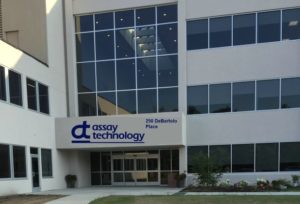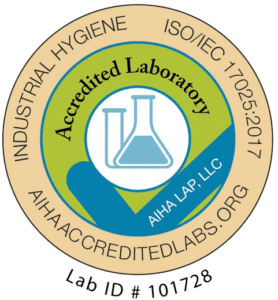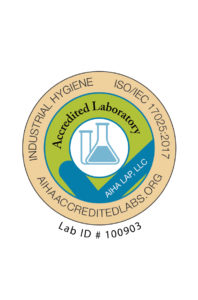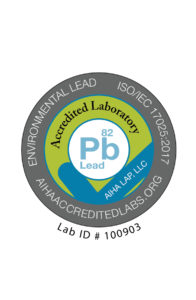
Assay Technology, Inc. owns and operates two industrial hygiene laboratories. One laboratory is in Boardman, OH and the other is in the corporate office in Livermore, CA. The laboratories maintain separate accreditations from AIHA-LAP, LLC, but utilize the same LIMS system and quality assurance program. Manufacturing, customer service, accounting, shipping, etc. are primarily done in the California office. The laboratory in Boardman focuses almost exclusively on performing analyses. The resources listed below are primarily for customers sending in samples for analysis at one of our labs. Resources for customers of the badges only (other IH labs or customers with another lab they like to use due to location, established contracts, etc.) are located in the “Air Samplers” section of the menu above.
Privacy and Confidentiality
To ensure that lab reports are sent to the correct person, customer accounts are filed by individual, not by company or workplace. We ask that the person to receive reports be detailed in the “Send Lab Reports To” section of lab request forms and chain of custody forms. To maintain certified customer confidentiality, lab reports will only be released to that individual unless otherwise instructed. We require instruction if:
• The individual does not match the contact for an account number given.
• Required areas are incorrectly filled or left incomplete.
• Chemicals for analysis are not specified.
• Requested chemical/analysis requires permission to subcontract or is not available.
Please know that, while you will be contacted, this may lead to a delay in reporting. For more information on filling out your forms, please see our Lab Request Forms below.
General Lab Policies
Laboratory and sample receiving staff adhere to the following guidelines:
• Turnaround time starts upon a sample being received by our staff, not when it is logged in or confirmed. However, delays in turnaround time or confirmation may occur if paperwork is missing or incorrect.
• Unless otherwise indicated, staff will follow instructions as stated on the lab request form as closely as possible.
• In the case of damaged, missing, or incorrect media types, the customer will be notified of the discrepancy and the sample voided.
• For media not manufactured by Assay Technology (cassettes/tubes/wipes/tabs): because blanks need to be analyzed at the same time as a sample to be applicable, a lab blank will be added to a batch when one is not apparently present. If you included a blank whose name is otherwise titled, please indicate so upon sample submission. Resulting analysis or media charges will be invoiced after analysis is completed.
• Extra analytes selected on the paperwork will be automatically processed regardless of the number of chemicals that were prepaid when originally ordered. Your chemical requests are not limited by your original purchase and instructions on lab request forms are prioritized. Analysis charges will be invoiced accordingly.
Rush Analysis
To guarantee reporting time, ALL rush requests need to be confirmed and scheduled with our staff prior to our receiving the samples. Due to lab scheduling, sample processing, analysis, and extraction methods, there are times when a service may not be available. To ensure your rush request is met please:
• Contact us at custservice@assaytech.com or by phone at 800-833-1258.
• Inform us of the date we will be receiving your samples.
• Notify us the quantity of samples we are to receive for rush processing.
• Notify us which chemicals you will be requesting.
• Have your samples arrive by 10:30am local time (priority delivery).
Please know that rush fees will apply and will be invoiced according to the appropriate service level. Service is only billed after report completion. Please see our Service Price List for details. If the rush analysis is a subcontracted analysis, an extra day will need to be added to rush time for processing between labs (e.g. a 2 day rush would instead take 3 days).
Subcontracting to Outside Laboratories
If we are unable to perform an analysis, but can contract another AIHA-LAP, LLC accredited lab, we will offer to do so. We require your permission to subcontract to outside sources. Please know that, aside from analysis fees, an additional handling charge will apply to each sample batch that is sent.
Subcontracting Between Assay Technology, Inc Laboratories
Assay Technology, Inc. operates two laboratories, AT Labs in California (AIHA-LAP, LLC 101728) and AT Labs in Ohio (AIHA-LAP, LLC 100903). The laboratories may subcontract work to each other if necessary without further notice. On the confirmation of receipt and the final report, the testing laboratory will be noted.
Invoicing and Service Charges
Service charges for non-prepaid media can be found by analysis code on our Sampling Guide and compared to our Service Price List.
Lab service billing is done after an analysis has been completed. We ask that submitted samples have a purchase order (PO) number, project name, or a credit card number for reference when invoiced.
Please note that the minimum lab service charge is $50. Invoices that total under $50 will be charged the minimum. Invoices over $50 will be charged at true cost.
California Lab AIHA-LAP, LLC # 101728
Ohio Lab AIHA-LAP, LLC # 100903
What's in the Sampling Guide?
The Sampling Guide is a dynamic, filterable document. You can search by badge, chemical, CAS #, test group, etc. The guide will shorten itself to only show the applicable chemical. You can also pin chemicals to keep them visible while searching for other things.
The guide will show all media types that can be used to collect a chemical as well as the badge we recommend. For example, if you search for benzene, the data for the 525 badge is bolded because it’s the badge that we usually recommend. However, we also show the data for benzene on a 566 and 546 so you can determine the reporting limit if you are considering using one of the other badges. For instance, say you have a 566 badge, but want to test the air for a 525 recommended chemical, a 566 recommended chemical, and a 546 recommended chemical. You’ll be able to determine if the reporting limit will be adequate.
There is also a section for lab notes for each chemical which can be expanded by pressing the + sign. Reminders, requirements, and suggestions are all in the notes section.
Why can't some chemicals be analyzed together even though they can be collected on the same badge?
This question is best answered through examples:
Example 1: The customer wants to collect and analyze total hydrocarbons and isopropyl alcohol on a single 566 badge, but customer service calls and says it can’t be done. The customer is confused because both total hydrocarbons and IPA can be collected and analyzed on the 566. Customer service insists total hydrocarbons is a list C chemical and IPA is a list A chemical and therefore can’t be analyzed on the same badge.
- List A: Carbon disulfide is the primary solvent for extracting (nonpolar) chemicals from carbon. So, hexane and xylenes are OK, but methanol and acetone are not because their recoveries are too low. However, if you add another solvent (co-solvent) to the mix, you can add many polar chemicals to the list, including alcohols, ketones, and acetates. At AT Labs, we use benzyl alcohol. So, our standard solvent mixture is 97% carbon disulfide and 3% benzyl alcohol. For most badges received, this is an excellent solvent mixture. However, when you analyze for “Total Hydrocarbons,” you have to use a solvent mixture that doesn’t block the scan, which covers approximately C4 through C15. Benzyl alcohol blocks C11 through C13, so you can’t analyze for IPA without the co-solvent, and you can’t analyze Total Hydrocarbons with the co-solvent.
Example 2 (keeping example 1 in mind): Why is there a list B? List B contains chemicals that are blocked by the benzyl alcohol. Instead of benzyl alcohol, we use n-butanol, which blocks other chemicals, but again allows the lab to include many polar and nonpolar chemicals.
On the Sampling Guide, we show which chemicals can be analyzed together in the Test Group column. All chemicals within the same Test Group can be analyzed together (unless the Test Group is blank.) The guide allows you to filter by Test Group, so you can see everything that can be analyzed together. Keep in mind this works for other badges and chemicals as well, like amines, aldehydes, and metals.
How do I read my lab report? (Short video answer)
How do I read my lab report? (Detailed version)
Why doesn't my report tell me if I passed or failed?
Most commonly, a customer will use our badges to monitor a person performing a regular work task for a STEL (15 minutes) or PEL (8 hours), then they will compare their result to a published OSHA limit. If this was the only task that customers performed, and there were OSHA STELs and PELs for all chemicals, we would be able to set up a reporting mechanism that would flag the result as a “pass” or “fail”. However, this is not the case. Customers perform all kinds of different monitoring and use regulatory limits from several different agencies when evaluating their results. There is too much variety to set up a pass/fail system that would be acceptable for all our customers.
If you need assistance interpreting your report, feel free to contact us. We will point to the Concentration Found column and if applicable, the available regulatory limits. However, keep in mind, we are not a trained safety officer performing evaluations on your site and cannot make safety decisions for you. If you need the services of a certified industrial hygienist, we have many as our customers and can often find one that is local to you.
What do all the columns on my report mean?
We have several report formats, but this section describes our most common report. Open this Example Report to follow along with the numbers below.
- Lab Sample ID: Every sample that arrives at AT Labs is assigned a unique number.
- Lab Code: This indicates which AT Lab performed the analysis. ATOH = our lab in Boardman, OH. ATCA = our lab in Livermore, CA.
- Date Sampled: The date the sampling started. This information is provided by the customer. If no date is provided, this field will be blank.
- Client Sample ID: This is the identifier provided by the customer, if any.
- Media: Media that was tested. For our original TraceAir monitors, 521A means one cover removed during sampling and 521B means two covers removed during sampling. Newer TraceAirII monitors do not have multiple covers.
- Media Lot/Serial Number: Primarily used for AT badge lot and serial numbers. Each badge receives a unique serial number when manufactured.
- Analytes Requested: The chemicals tested. Keep in mind there are sometimes multiple names for the same chemical.
- Quantity Found
- Total: Amount of chemical detected on the sample. This intermediate number does not take into account the Sampling Time/Volume. This number is NOT to be compared to any regulatory limits. A “less than” sign (<) means the result is less than the reporting limit.
- RptLmt (Reporting Limit): This is the smallest amount of the chemical that can be reliably measured on the sampling media. This is NOT a regulatory limit, but rather a limit of the analytical method. It is also called a Limit of Quantification or LoQ.
- Units: This is the reporting unit of the quantity found. It is almost always “ug”, micrograms.
- Sample Vol (L): Volume of air collected during sampling. Sampling Volume (L) = Sampling Rate (L/min) X Sampling Time (min). For diffusive monitors, the sampling rate varies depending on the design of the badge and the size of the molecule. Need a sampling rate? Check our sampling guide.
- Time (minutes): The amount of time the media was exposed to the air. This number is supplied by the customer. If the customer only reports the sample volume on their COC, this number will be blank.
- Concentration:
- If there are no values here, the sampling time/volume was probably not provided on your paperwork. If you have this information, contact us and we will send a revised report.
- Found: This is the detected concentration of the chemical. This is the number to compare against a regulatory limit. It is the average concentration for the period of time monitored. It is an 8-hour TWA only if the sampling was for 8 hours.
- Units: This is the reporting unit the Found and RL values in the Concentration section are being reported in. It can change depending on what is applicable for the chemical of interest. For example, benzene will be reported in PPM, but lead will be reported in mg/m3. When comparing the Found value to regulatory limits, it is important to make sure the units are the same.
What equations are used to determine the exposure?
Exposure (ug/L) = Quantity Found (ug) on media/(Sampling Rate (L/min) X Sampling Time (min))
Exposure (mg/m3) = Exposure (ug/L) X (1 mg/1000ug) X (1000 L / 1 m3)
Exposure (ppm) = (Exposure (ug/L) X Molar Volume 24.45 (L/mole)/Molecular Weight (g/mole) of Chemical
The sampling rate is either the flow of air through an active sampler (cassette, tube) or the sampling rate for a specific chemical on a diffusive sampler.
Which column has the data that I am looking for?
In most cases, it is the FOUND column in the Concentration section.
Is the exposure a "TWA?"
The exposure on our report is the analyte’s average concentration in the air for the period of time that was monitored. It is NOT necessarily an 8-hour time-weighted average (TWA). It is only an 8-hour TWA only if you monitored for 8 hours. If you want to convert the exposure to an 8-hour TWA and do not know how, please call for technical support at 800-833-1258. Based on what you know about the environment that was sampled, you will need to decide what happened while you were not monitoring. For example, if you monitored for 5 hours, then what happened during the other three hours? Do you expect the exposure rate would not change or did any possible exposure end?
Is the Concentration Reporting Limit the regulatory limit?
No. The reporting limit is the lowest concentration the analyte would have to be present in for it to be detected by the analytical method. It is our goal to have the reporting limit be no more than 1/10th (one-tenth) of the applicable regulatory limit when a customer monitors for expected time periods. So, it is very possible for an analyte to be detected, but not be over the regulatory limit.
Why do the Concentration Reporting Limits vary on my samples even though I am testing for the same chemical?
The reporting limit will vary from sample to sample because it is a function of time. The longer the sample time, the larger the sample volume, which increases the sensitivity of the badge and provides a lower reporting limit. Conversely, a shorter sample time will result in a smaller sample volume and higher reporting limit.
For diffusive monitors, the reporting limit for different chemicals on the same monitor will vary as well. Chemicals diffuse into the monitor at different rates. A big molecule will diffuse slowly, while a small molecule will diffuse relatively quickly. The sampling rate will therefore vary depending on the chemical, which means different sample volumes, which means different reporting limits.
What is Total Quantity Found (ug)?
This is an intermediate measurement used in the calculation of the concentration. It is not to be compared against a regulatory limit. The quantity it is referring to is the amount of the analyte that was found on the sampling media in micrograms (ug). Once this number has been determined, the sampling time and sampling rate of the badge are applied to calculate the exposure (ppm).
What does "ND" mean?
ND stands for “None Detected” at or below the reporting limit. In other words, the concentration was so low that the instrument could not detect it.
My result is over the regulatory limit. What do I do now?
It is Assay Technology’s intent to provide smart, effective products and services that people can utilize in their health and safety plan. We are not in a position to be able to manage a company’s safety concerns. However, customers frequently choose to monitor the area of concern again, reevaluate their safety equipment (hoods, scavengers, etc.), reevaluate their procedures, and/or hire a safety consultant.
Why are the regulatory limits on the reports?
Many customers have asked for Regulatory Limits to be added to our reports. We were hesitant to put them on our reports because it is impossible to put all applicable regulatory limits on a single report template. In general, if an OSHA limit was available, we have referenced it. If there was no OSHA limit, we have referenced a NIOSH limit. When there were none available, the section was left blank. Please read the disclaimer on the report. Clients should be aware that more stringent international, state, local, or organizational exposure limits may supersede the limits included with the report. Because of this, some customers have asked that we NOT have regulatory limits on their reports. Clients wanting regulatory limits removed from their reports should contact our customer service department. It is a simple update to your account.
My result is so high, I suspect there may have been an error. What could have gone wrong with the monitoring?
It is important to thoroughly explore the possibility that there is no error and the concentration reported properly reflects the concentration of the chemical in the air. However, errors certainly are possible. For diffusive monitors (badges), probably the most common error that leads to a very high result is when the badge is splashed with the chemical. Even a tiny droplet can cause a significantly high result. Also, if someone touches the badge while they are working with the chemical of interest, a false high result is possible. These errors tend to lead to extremely high results. Other errors, like not handling the monitors as specified by the manufacturer, are possible and can also cause results to be biased high. Finally, it’s possible there was something wrong with the sampler itself or with the analysis at the lab. We work very hard to make sure this does not happen, but we are happy to investigate your concerns when they come up.
What does the message "Caution: Sample not returned within manufacturer's maximum recommended holding time" mean?
Most chemicals are not stable on sampling media indefinitely. There is a length of time between sampling and analysis where the accuracy of the result might be affected due to chemical breakdown, reverse diffusion, etc. Based on storage stability data for a particular monitor, samples that arrive back to the lab after the recommended holding time has been exceeded are flagged with a note to use the data with caution. In many cases, it is not possible to determine exactly how much the results have been affected. However, a badge that should have been returned within a week, but was stored in a freezer for 2 weeks before it arrived at the lab will be less affected than a badge that was stored for 2 weeks in an unairconditioned warehouse in the summer. Recommended holding times are listed on the technical inserts included with all Assay Technology products.
What if I return the badges on the last day of holding time and the lab doesn't analyze the badge until after the holding time expires?
It is important to keep in mind that holding times are the recommended amount of time between when sampling occurred and when the badge is delivered to the lab for analysis. It is a recommendation, not a requirement. However, the longer the badges are stored, the more likely there can be a quality issue, such as a high bias due to contamination during storage. It is the lab’s responsibility to store the badges properly until the analysis can take pace, but, except in the case of the 595 badge, the analysis does not need to take place immediately.
If the badges are returned outside of the recommended holding time, the lab will include a note on the report. This does not mean the result is invalid. However, upon reviewing and interpreting the results, the customer should keep the notification in mind.
Why does the result say "VOID?"
When each sample is received, it is checked to see if it is in good condition. If there is a significant problem and any result that would be obtained from analyzing the sample would be severely compromised, then the lab will not proceed with the analysis. When this happens, the report will read “VOID” in the quantity found column and no exposure will be given.
I included a field blank with my samples and the result was over the reporting limit. What does this mean and what do I do?
Field blanks are used to evaluate any background collected on the sampling media during storage, handling, and shipping. Reports provided by AT Labs will be lab blank corrected, but not field blank corrected. If you want your report to be field blank corrected, include a note on the Lab Request Form or contact our customer service department. This can be done before or after the report as been completed. For some chemicals, it is common to find low level values in field blanks and is not cause for alarm. These include formaldehyde, ozone, acrolein, and nitrous oxide. In most cases, the background found on the blanks is insignificant to the sample results and/or regulatory limit and can be noted, but not acted upon. There can be cases where field blank results are 5 to 10 times above the reporting limit and can be cause for inquiry. Problems might include sample mislabeling in the field or lab and severe sample cross contamination due to high exposures. Dr. Charles Manning, PhD, CIH, Assay Technology’s Technical Director, authored a document on the subject of field blanks: Blank Correction Of Air Samplers. You can also learn more about using and interpreting field blanks in our blog post, The Secret Lives of Field Blanks.
I did not receive my report.
You should receive both the lab work order confirmation and the final copy of your report via email as a PDF. However, if a confirmation of receipt or a report is not received, there are a few potential explanations.
The most common issue causing unreceived reports is that your email server or company firewall saw the email with the attachment from custservice@assaytech.com, our reporting email address, as potential SPAM and put it into your junk folder. If a report is found in your junk folder, the email server will have to be told to allow emails from our account. Please contact your company’s IT administrator to resolve this.
If you do not see a confirmation or reporting email in your inbox or spam, please contact our customer support at 800-833-1258 or custservice@assaytech.com to check that the email address we have on file is correct. Typos on the lab request forms or when entering your email address into our system might be to blame, but it’s also possible there was an issue with your sample(s) which delayed analysis.
Do I need a hard copy of the report mailed to me?
No. Previously, only draft reports were emailed or faxed automatically. The only official versions of the reports were the reports printed on letterhead and mailed. Now, the reports emailed and/or faxed are official copies of the report since they are on company letterhead. That means customers no longer need to be mailed hard copies of the reports. For all the report options, including an Excel readable summary of your data, contact our customer service department.


